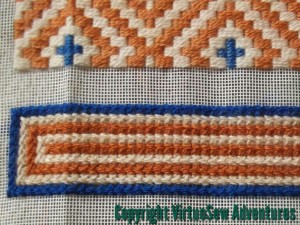
First Side Panel Completed
When last you saw the Stones of Venice Footstool, I was lamenting the speed with which I had finished the top panel, which had brought me face to face, far too soon for comfort, with the challenge of deciding what to put on the side panels.
I had originally thought to devise a smaller pattern, of some sort, borrowing from some of the ideas in the comments on the last post and from any convenient pictures of the Doge’s Palace that I could find online, but when it came to it, I felt that it might prove both difficult and unrewarding to create repeating patterns which worked well beside the larger pattern on the top.
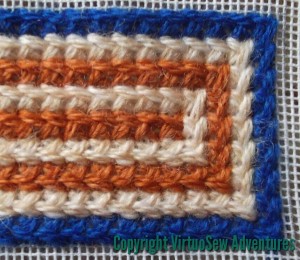
Side Panel Close Up
My first step, therefore, was to bring the blue more to the fore by creating a blue border for each panel. It seemed to me that this would help the side panels to stand away from the top and set it off nicely. After much poring over my needlepoint stitch books I settled on Greek Stitch, which is a sort of long armed cross stitch. Again, this solved the question of having the stitches running with the top on some of the sides and against on others, which had been worrying me quite a bit.
I worked out a way to turn the corners so that each side panel could be a self-contained unit, and decided to to work all four borders while I considered my next move. Which floated swiftly to the top as I stitched. The blue on the top panel was the central motif, and on the sides was forming the edge – so the obvious continuation was to reverse the order of the colours. Challenge met, I think!
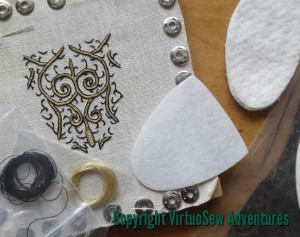
Starting the finishing on Lady Catherine’s Slipper
It has taken me a while to finish the embroidery for the Lady Catherine’s Slipper Needlework Nibble. In part this is due to our usual modern complaint of Life in general getting in the way, and in part it is due to my aversion to black. It will look lovely when it’s done, but anything that involves me working with black thread rather than any other colour is always going to be low on the list. However, now it is done, and I move on to the question of Finishing…
Which means being a brave girl and messing around with glue, close to my careful stitchery and some absolutely gorgeous silk brocade.
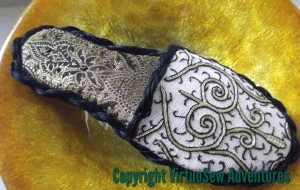
Lady Catherine’s Slipper
Since glue is involved, and has to dry between each stage of the assembly, it took several episodes, spread over a couple of days, but I got there in the end, and I’m very pleased with it.
I photographed it lying across a Limoges enamel bowl belonging to my parents, so that it would show up nicely against against the glossy enamel background.
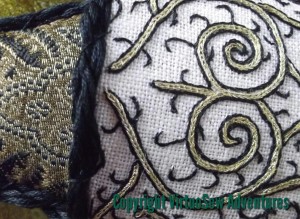
Close Up of the Slipper
The gold thread is a really fine one, and the spidery black tendrils embellishing the black border help it to stand out against the base fabric.
My cord-making skills could use some improvement, I think, as the cord sewn around the edge isn’t entirely even, nor is it as tightly twisted as I would have liked. It is, however, rather better than the one I made for the Glittering Snail, so at least there are signs that Practise is indeed Making Perfect!
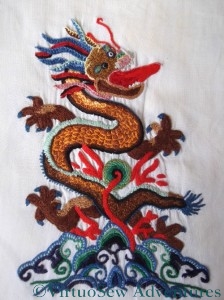
Kai Lung
This wonderfully contorted Imperial Dragon was another Needlewoman Magazine design (March 1934), and he got his name from the Golden Hours of Kai Lung, by Ernest Bramah, which I was reading at the time, because it had been mentioned in one of Dorothy L Sayer’s books (“Strong Poison”).
The pearl cotton I used was really too heavy for the base fabric – another old piece of linen – but it gave a fantastic lustre to his scales, which were worked using nested fly stitches (not my idea – I followed instructions on this piece!).
The tongue is closely-set stem stitch, the claws are fly stitch (so are the teeth – I think the designer liked fly stitch!) and the mane is made of interlocking blanket stitch. I worked very hard on this piece, to keep the stitches neat and even, and I used to take it with me to visit Grandmama when she was in hospital. There’d probably be a riot now if I sat at a hospital bedside, embroidery in hand, but Grandmama enjoyed watching me work and made a lot of useful and encouraging comments as well.
The magazine no longer had its transfer of the Dragon, which was intended as a Firescreen (other suggestions included the back of a bridge coat, a footstool, a cocktail tray, a cushion…), so I worked it at the size of the diagram in the magazine, on the back of a dress. Had I worked him full size, he’d have been too big for the dress.
I was thrilled when the wife of one of my father’s friends recognised it, told me that she had worked it herself when the magazine came out, and fished out the firescreen she had made using the design the next time we went to see them. She was the person who told me that you can tell he’s an Imperial Dragon, because he has five claws. She’d worked it in pastel shades to go with their drawing room of the time, and it was absolutely stunning. She and her husband are both dead now. I do hope that that screen found a happy home!

I Wonder What Happened
I’ve been rummaging in the archives of late, in particular in a pile of papers left by my Grandmama. I don’t know which newpaper this was cut out of, but it describes Mrs Peggy Jones’ passion for drawn thread work. I’ve done a little googling, and I’ve not found any reference to either the journalist or Mrs Jones in relation to drawn thread work. She mentions unpicking it to work out the stitches, and taking a year to work a tablecloth – all of which I think we can all relate to!
Grandmama didn’t do any drawn thread work that I’m aware of, so I don’t know why she cut it out, unless it was surprise and delight to find any form of needlework in a newspaper.
I’ve scanned the article so that you should be able to read it – maybe if we all keep asking, we can find out what happened to Mrs Jones and her stitchery?
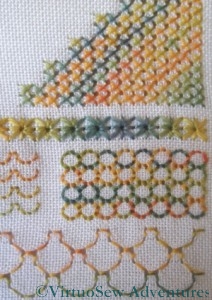
Pulled Work Detail 3
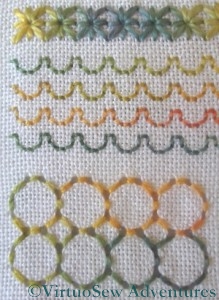
Pulled Work Detail 4
There are so many pulled work stitches that I was in more danger of running out of patience than of running out of stitches.
Star Stitches in the heavier thread create a strong horizontal divider, with the colour change rippling across the fabric.
Then I worked two pulled work stitches each at two different scales. One of the patterns creates something a little like festooned curtains, another creates the effect of a tiled roof. Although I worked this many years ago, this playing with scale is something that, when I was doing the Tudor and Stuart Goldwork Masterclass, I came to realise was a very important element of stitch choice and effect.
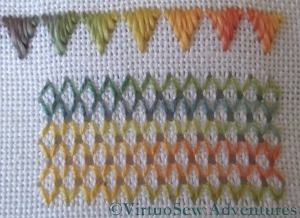
Pulled Work Detail 6
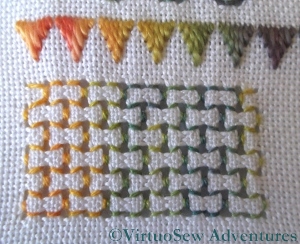
Pulled Work Detail 5
Again the heavier thread made a good divider, this time a dagged edge straight out of medieval heraldry, and then Wave Stitch ( the right- hand picture – possibly not pulled tightly enough!) and a brick pattern follow on.
I still cannot recall what I had in mind when I started this piece, except, perhaps, that I wanted to use the citrus-coloured thread for something. I think that if I were to start this again, I would work a narrower sampler and start by working the pulled stitches in a fine self-coloured thread. It seems to me now tht the pattern of spaces might be more interesting, in fact, than the stitches themselves.
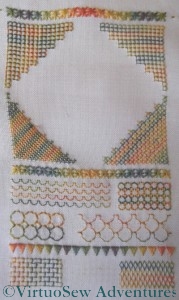
Pulled Thread Sampler
All my regular readers will know that while I’m very keen on experimenting with techniques that are new to me, I’m not so good at finishing what I’ve started.
I found this panel when I opened a box in the office that I’ve been ignoring for a while. I can’t even remember how long ago I started it, and you can see that although I worked it on a frame, it’s got somewhat out of shape while it’s been rolled up, because of the varying tension up and down the length of it. There’s less variation across the width, which strikes me as strange since I’m sure I used a roller frame, and didn’t tension the weftwise direction!
The sampler is worked using another pair of Caron Collection threads, the fine Wildflowers, and heavier Watercolours, in a bright orange and green overdye. I love the texture and colours of these threads, and they highlight the stitches beautifully. The fabric itself is Jobelan, which is a regular even-weave fabric, perhaps not quite sufficiently widely-sett for pulled work to show to its best advantage.
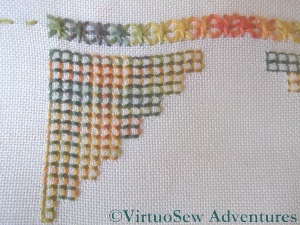
Pulled Work Detail 1 – Four Sided Stitch
It occurs to me as I look at the photos that pulled work can be done with two different effects in mind – one using the pattern of stitches to create the effect, and the other using a much finer, self-coloured thread, creating the effect with the pattern of holes left by pulling the fabric threads together. Something else to try!
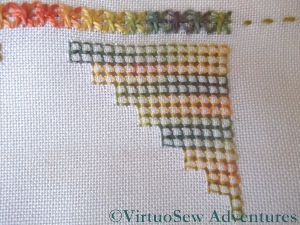
Pulled Work Detail 2 – Four Sided Stitch Again?
After beginning with a row of Star Stitches in the heavier thread, the first corner of the square panel is in Four Sided Stitch. What puzzles me about this is that the second section seems to be in the same stitch, whereas the two lower corners differ. It seems to me that this was a genuine sampler – I was making it up as I went along!
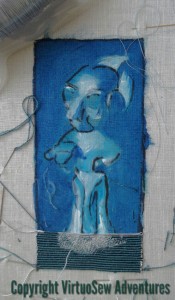
Progress On The Amulet
Now that I have started on the main design element of the Hittite Amulet, I am entering a familiar and disheartening stage. There is so much more to do, it’s very concentrated work, and at the moment, I’ve not done enough to be confident it will work at all.
In fact there is a good chance that until it is completely finished, I won’t be sure that it is working, which in turn means I need to ignore my doubts and just keep at it!
The fact that I have several needles with different shades of thread in them, all working at once, will explain why I can’t do very much at a time – I need to avoid tangling the threads, and as soon as I start to get tired, the threads tie themselves in such convoluted knots they’d make a macramé expert think twice!
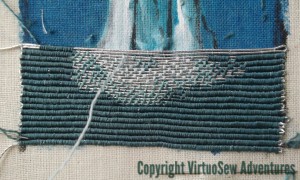
Many Threads In Progress
This close up should give you an idea of what is involved. I decided to allow the coloured silk stitches on the Amulet to be either across the same pair of threads as the background, or across pairs which are off by one. This should allow me to be a little more precise in colour placement. It may or may not matter, but I felt that since this is such a strange piece, I wanted to have as much flexibility as possible.
I have already discovered that in some ways the straight rows are harder than the spiral that I used for Christus Natus Est. As the backing fabric sags, and the stitching became more widely spaced over the Amulet, I found that the rows were no longer straight. I’ve spent several sets of rows geting the rows more or less straight again, which was just a little scary!
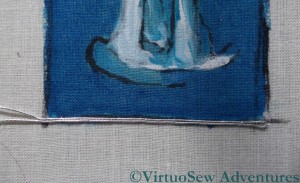
First Silver Row
So, with the Hittite Amulet painted on my fabric, stretched, and ready to go, I have now settled down to stitch. I have decided to aim for a more strongly corded effect in the background of this piece than I used for Christus Natus Est, so each row of stitches will be worked over two rows of silver.
This in turn means that I will spend a lot of time wrangling the springy silver thread to make it lie close and straight. Even the first row was a challenge, and as I reach the core of the spool and find the thread that has been wound closely around it, I am expecting the challenge to become even more challenging!
Still, nothing easy was ever worth doing – so they say…
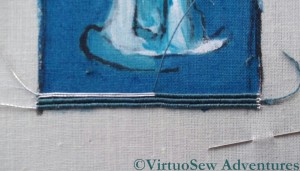
Covered In Silk
This second photo shows the stitching halfway along the third row of background at the base of the piece. You can see the ribbed effect is already building up, and it will create a good strong background. If I get the rest of it right, the Amulet should almost pop out of the surface at me!
I am still trying to decide how to organise my stitching of the Amulet himself, but I plan to allow the silver to show through across the entire design, spacing my silk stitches accordingly. The stitches for the design may cover two silver threads or only one, and I am going to try to space them using the original black and white photo for guidance, to create some sense of the shadows breaking up across the surface.
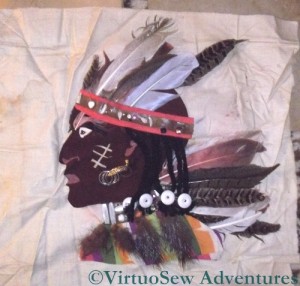 Grandmama joined the Women’s Institute at some point, and went on many of their craft courses of one sort or another. When I found this collage, I also found one of her notebooks with notes from some of those courses, which I hope will enlighten me about how she approached them. When I get around to transcribing them, that is. It is one of those tasks that always gets put off to a more convenient time!
Grandmama joined the Women’s Institute at some point, and went on many of their craft courses of one sort or another. When I found this collage, I also found one of her notebooks with notes from some of those courses, which I hope will enlighten me about how she approached them. When I get around to transcribing them, that is. It is one of those tasks that always gets put off to a more convenient time!
I’m especially curious about this one. I’d never seen it before – a collage of an Indian’s Head. A fictional one, I imagine. In fact the question I find myself asking about this is “Why?”. Most of it is glued rather than stitched, which I rather imagine would have gone somewhat against the grain with Grandmama. It also has the slightly slapdash feel that my own work has when I’m feeling out-of-sorts about being forced to do something I dislike or consider uninteresting. Maybe the notes will tell me more.
However, I was highly entertained when I realised that the ornaments on the end of the Indian’s braids were trouser buttons from my Grandfather’s Tropical uniform – it’s a good thing he’d retired by then!
Although I have already commented that I usually regard Online University pieces as tutorial pieces to be worked according to the instructions, I’ve decided to make a few changes on the brim. This will mean I will be able to compare directly some of the working methods I’ve learned about since I began on the Nightcap, so I should learn even more!
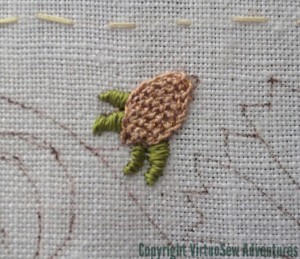 The first change was to use Bordered Corded Brussels Stitch for much of the detached buttonhole stitch. I can’t say that I am finding the Gilt Sylke Twist markedly easier to use now than it was when I started. However, I do find that the Bordered Corded Brussels stitch is easier than working Detached Buttonhole with return into a border of chain stitch, and less prone to breakages of the gilt wire.
The first change was to use Bordered Corded Brussels Stitch for much of the detached buttonhole stitch. I can’t say that I am finding the Gilt Sylke Twist markedly easier to use now than it was when I started. However, I do find that the Bordered Corded Brussels stitch is easier than working Detached Buttonhole with return into a border of chain stitch, and less prone to breakages of the gilt wire.
In the case of the strawberries I have also chosen to use satin stitch in place of trellis stitch for the sepals. I’ve padded the satin stitch, to give it a little more life.

New Version Pansy
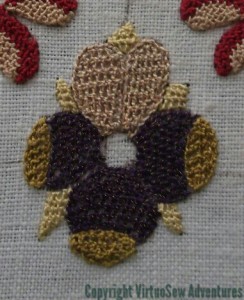
Old Version Pansy
There are changes to the Pansy too. Again, the petals are worked in Bordered Corded Brussels stitch, but the curled edges I worked in satin stitch. The outer edge is padded with a line of back stitch to lift it a little. Possibly not enough, so when I work the second pansy I might choose to pad the edge with chain stitch, or whipped back stitch to see whether it makes a difference.
The straw-coloured sepals are unpadded satin stitch this time, rather than the trellis stitch suggested in the instructions. It’s much less fiddly to do, but I wonder whether these changes rather undermine the style, looking a little too modern, too simple, too plain.
And if there is one thing I have learnt from the exhibition “In Fine Style“, and from its fabulous book, it is that the Tudors believed very much that more is more – more texture, more glitter, more colour, more everything.






















